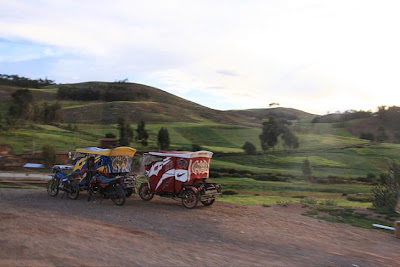Diariamente saem de Cusco inúmeras excursões que levam os visitantes ao Vale Sagrado dos Incas. Apesar de não gostar de viajar em grupo e raramente fazer qualquer passeio desta forma, resolvi conhecer o Vale Sagrado com a programação oferecida por uma agencia de viagem de Cusco. A paisagem é deslumbrante, porém, me arrependi profundamente de não ter feito a viagem sozinha uma vez que os guias sempre priorizam as visitas aos mercados de artesanato e o tempo para conhecer as ruínas é reduzido. On daily basis there are numerous day trips from Cusco that take the visitors to the Sacred Valley of the Incas. Although I do not like to travel in groups and I rarely do it, I decided to go to the Sacred Valley with arrangements made by a travel agency in Cusco. The scenery is breathtaking. However, I deeply regretted not having gone on my own as the guides always spend so long visiting the craft markets and the time to explore the ruins is reduced.
Em Cusco é vendido por um órgão do governo um “Boleto Turístico” que custa cerca de USD 50.00 e é válido por 10 dias. Este boleto dá direito a visitar os principais sítios arqueológicos e museus em Cusco e arredores assim como uma apresentação de dança folclórica. In Cusco is sold by a government agency a "Tourist Ticket" which costs about $ 50.00 and is valid for 10 days. This ticket entitles you to visit the main archaeological sites around Cusco, museums as well as a presentation of folk dance.
O Vale Sagrado dos Incas está localizado entre as cidades de Pisac e Ollantaytambo e é banhado pelo rio Urubamba. Para se chegar ao complexo arqueológico de Pisac é preciso viajar por uma estrada sinuosa com grandes precipícios. Na estrada há placas que indicam que a velocidade máxima é de 35km/h mas o nosso motorista dirigia a 60km/h. Perguntei para a guia o porquê das leis de trânsito não serem respeitadas uma vez que estávamos viajando por uma região extremamente perigosa. Ela ficou até surpresa com a minha pergunta, mas percebi uma pequena diminuição na velocidade do ônibus na descida da montanha. The Sacred Valley is located between the towns of Pisac and Ollantaytambo and connected by the Urubamba River. To reach the archaeological complex of Pisac you must travel along a zigzagging road with enormous cliffs. On the road there are signs that indicate the maximum speed is 35km / h but our driver was driving at 60km / h. I asked the guide why he was not following the signs as we were traveling through a region extremely dangerous. She was a bit surprised by my question but I noticed a small decrease in speed of our bus on the way down the mountain.
Os ônibus chegam até este ponto no qual há muitos vendedores ambulantes. This is where the buses stop and there are many street vendors.
Para se chegar até as ruínas das construções incas é preciso subir muitos degraus e caminhar por trilhas estreitas até o alto da montanha. A vista belíssima do vale compensa o esforço.To reach the ruins of the Inca’s constructions you need to climb many stairs and walk through narrow paths up to the top of the mountain. The beautiful view of the valley is worth the effort.
Nas montanhas próximas os cemitérios incas nos quais os corpos eram enterrados em posição fetal. The Inca cemeteries were in the nearby mountains and the bodies were buried in a fetal position.
Os grandes terraços de plantações circundam as montanhas e são vistos por toda parte nesta região. Large terraces used for crops surround the mountains and are seen everywhere in this region.
Ollantaytambo é uma das poucas cidades na qual as pessoas ainda vivem em casas construídas pelos Incas. A cidade sempre teve uma grande importância para os Incas porque para se chegar a Machu Picchu é preciso passar por Ollantaytambo. Era uma forma de controlar quem ia entrar na cidade. Este sistema perdura até hoje uma vez que o trem com destino ao povoado de Machu Picchu sai de Ollantaytambo onde o passaporte dos visitantes é checado.
Ollantaytambo is one of the few cities where people still live in houses built by the Incas. The city has always played an important role for the Incas because it is the route to Machu Picchu and in order to get there you must go through Ollantaytambo. It was a way to control who would enter in the city. This system continues today as the train to the village of Machu Picchu departures from Ollantaytambo and all visitors have their passports checked.
Nas montanhas esculturas feitas pelos Incas como o rosto na lateral da montanha. In the mountains there are sculptures made by the Incas. On the left side of the mountain the face of a person.
Os Incas construíram depósitos para armazenar alimentos no alto das montanhas porque sabiam que a temperatura fria permanente possibilitava a conservação dos mesmos por períodos de até cinco anos. The Incas built warehouses to store food in the mountains because they knew that the cold and permanent temperature would preserve it for up to five years.
Fotos que eu tirei de dentro do ônibus quando estávamos indo para Chincero. These photos I took from the bus on the way to Chincero.
Chegamos a Chinchero no final do dia e só tivemos tempo de assistir a uma demonstração de como a lã é tingida com corantes naturais. Gostaria de ter visitado a cidade. We arrived in Chinchero at the end of the day and we only had time to watch a demonstration of how the wool is dyed with natural dyes. I wish I had visited the town.

.JPG)















































Que lindas fotos Audy! Adoro os seus relatos de viagens e me imagino "viajando" pelos lugares que você descreve! Beijos, Rô
ResponderExcluirOlá Rô,
ExcluirAcho importante escrever para "reviver" a viagem e dar voz as fotos.
Obrigada pelo carinho!
Beijos,
Audy